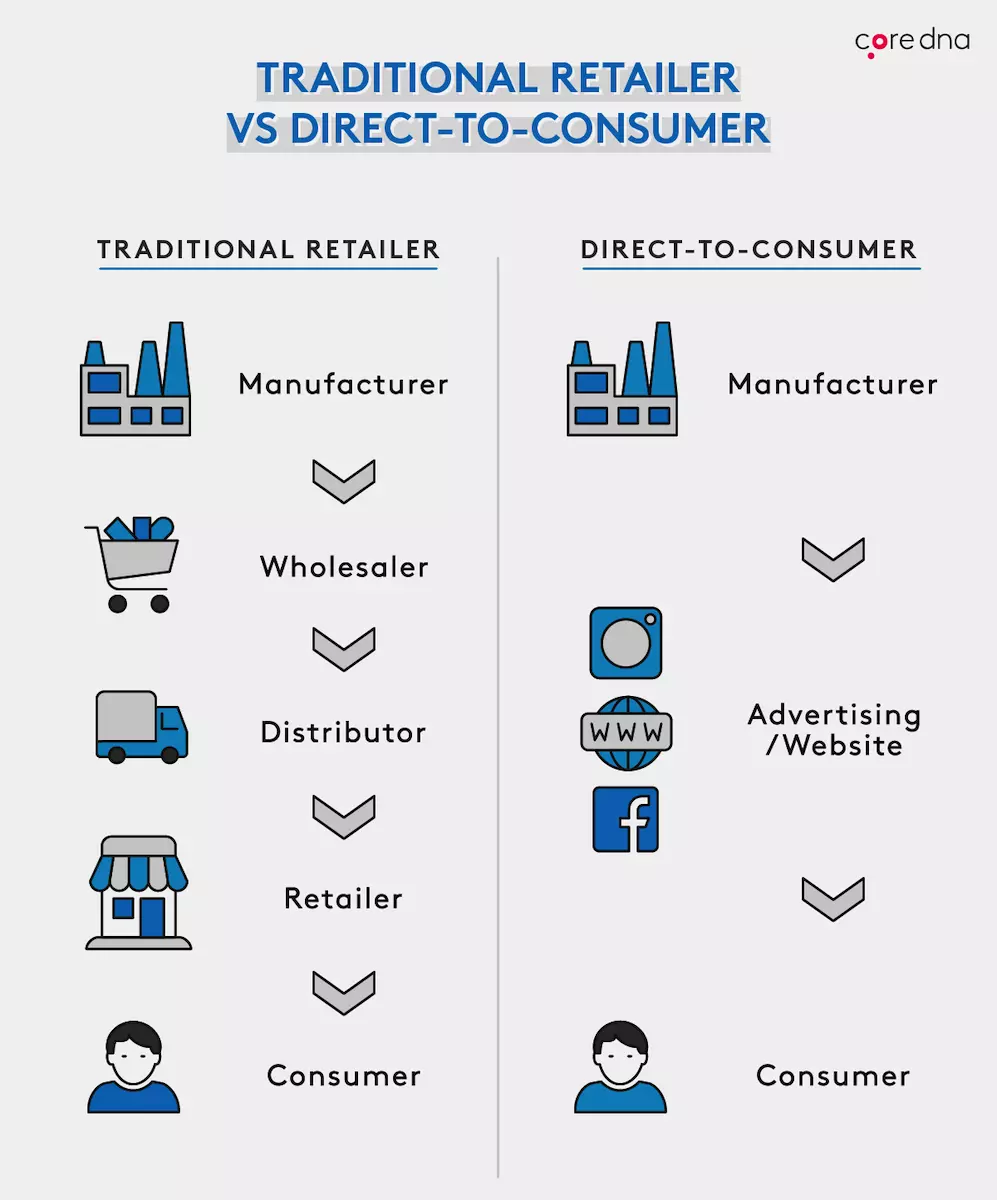When ecommerce was still in the early stages, the direct-to-consumer business model was so innovative that new companies could grow to multi-million dollar enterprises in just a few years. Companies that would traditionally leave the sales pitch to large retailers, were using the internet to send their message directly to consumers, and consumers were listening.
Today the landscape is much different. The last year brought such an influx of new players to ecommerce, that competition for consumers’ attention and loyalty is driving most of the DTC trends we’re going to see in 2021.
DTC brands who succeed, will follow these trends and offer consumers a relationship instead of simply a transaction, utilizing as many of the new tools available to give customers a smooth, personalized experience from beginning to the end of the customer journey. Listed below are our top three DTC strategies for customer acquisition to try.
What is the direct-to-consumer business model?
Direct-to-consumer (DTC) businesses manufacture and ship their products directly to consumers without the use of a middle man.
CaWhen online shopping was still in the very early stages, a few innovative companies like Casper (mattresses) began to market directly to consumers with a simple message and an emphasis on the customer experience.
Since those days the DTC model, characterized by borrowed supply chains, online-only retail, direct distribution, and social media marketing, has exploded.

With accessible start-up and scaling costs, a 2019 report counted over 400 DTC brands on the market and that number is likely even higher today.
How are brands moving to ecommerce DTC in 2021?
With such a large segment of the retail customer experience moving online, consumers are drawn to DTC brands that offer a personalized experience.
This means that even if they tend to buy from marketplaces like Amazon or target.com, they are looking to buy products with a relatable brand story, accessible customer service, and reliable delivery methods.
To match these evolving consumer demands, brands who want to move to ecommerce DTC in 2021 and succeed, need to pay attention to several key factors in their direct-to-consumer business model:
Providing a Unified Customer Experience
Brands need to constantly evaluate their omnichannel presence, ensuring consistency in the customer’s experience as well as a smooth transition between platforms.
Focusing on Personalization
Choose the right platforms and plug-ins to allow for personalization at key points in the customer journey, as well as mobile adaptability and eWallet integration.
Flexibility in Operations
Brands should prepare for changes to both their supply chain and cash flow as they move from fulfilling a few large orders to wholesalers to the higher frequency of smaller orders in the DTC market.
Optimizing Logistics
Reliable delivery drives many online buying decisions. Brands moving to DTC need to optimize the logistical side of order fulfillment and shipping to ensure reliable delivery to consumers all over the world.
Collecting the Right Data
As a company grows, it’s important to install proper tracking tools and attribution software in order to gain a clear picture of where new customers are coming from and what motivates existing customers to buy more.

Direct-to-consumer marketing in 2021
DTC marketing is becoming more personalized as tracking tools and software integrations allow for more targeted marketing. But beyond smart algorithms and sophisticated funnels, direct-to-consumer brands who want to stay the course in 2021 also need to foster a sense of community with their customers.
DTC brands with a relatable brand story will be able to get their message across on social channels to more potential customers and stand out from their competition. A winning direct-to-consumer marketing strategy is all about building a relationship with the consumer.
Brands who are following the guidelines below are finding a way to cut through the noise in ecommerce marketing today and bring loyal customers to their brand.
Consumers Are Loyal to Brands Who Offer Transparency
DTC marketing offers a unique opportunity for DTC brands to speak 1-on-1 with their customers.
Brands who share their values and give a behind-the-scenes look at their company are able to establish an emotional connection with consumers. This emotional connection is essential for both attracting and retaining customers over the long term.
Customers Are Coming to DTC Brands for Reasons That Aren’t Sales
Today the average consumer carries around a comparative shopping tool in their pockets, and that’s exactly how they use it. Brands that treat their customers as users, not as buyers, set themselves apart as a go-to resource.
DTC brands are doing this by offering relevant lifestyle content, concierge shopping services, and a focus on customer success.
Social Influencers Are the New Word-of-Mouth
Nothing beats the instant trust won when people share their positive experience with a company to their friends and family.
Since the direct-to-consumer business model has a global reach, social media, and specifically influencers who dominate social media content, are one of the best ways to take the benefits of word-of-mouth advertising and move it online.
Customer Acquisition Strategy in 2021
The year 2020 ushered in a new era for virtually every sector of the economy, but none more dramatically than online. Trends that were projected to reach their peak in five to ten years, hit many of those numbers in a mere 3-6 months.
The sudden increase in online shopping has changed the way all types of brands are looking at their customer acquisition strategy. Using the best tools that are available in video, AR, VR, and AI, brands are working to build interactive and personalized digital experiences for their customers. As consumers’ needs change along with the course of the pandemic, brands need to adapt to these customer’s needs in order to be in demand.
Following the roller coaster of 2020 when it came to advertising costs, brands should be strategic by leveraging marketing channels with a high ROI, as well as constantly testing and tracking to find out what is working. Along with choosing the highest performing channels, brands need to invest heavily in customer acquisition by offering discounts, payment terms and delivery options, luring consumers away from other brands with their more attractive offers.

DTC strategies for customer acquisition
While brick-and-mortar sales continue to dominate the retail market, ecommerce brands face their greatest challenge when it comes to customer acquisition.
Customer acquisition strategy for DTC brands needs to focus specifically on two areas: The customer’s experience and finding underpriced attention in the digital marketplace.
Upgrading the customer experience means finding ways to reduce friction in the online shopping experience. Brands can do this by offering seamless, omnichannel shopping, the use of augmented reality (AR) that allows customers to “try out” products virtually, and strategic communication with the customer to ensure the customer feels connected to your brand.
Getting the customer’s attention is at the forefront of all customer acquisition strategies. Pinterest is fast becoming one of the best customer acquisition tools for DTC brands because the majority of their users are making non-branded searches. This allows DTC brands to get their products discovered by an increasing number of potential buyers. Other platforms like YouTube, TikTok, and podcasts are great tools for DTC brands, especially as the cost of advertising on platforms like Google, Instagram, and Facebook, continues to skyrocket. In all social channels, DTC brands need to use creative marketing that brings in customers who don’t feel like they are being sold to.
How Has COVID Affected DTC strategy?
Over the last ten years, the direct-to-consumer trends have matured and changed. The effect of the COVID-19 pandemic has changed the landscape much more rapidly.
At the end of the third quarter, 2020, E-commerce sales accounted for 14.1% of total retail sales, a 36.7% increase from the year before. (source: census.gov). This sudden increase in ecommerce shopping has brought us a very crowded online market, heading into 2021.
The ecommerce trends brought on by the COVID-19 pandemic have created an increasingly competitive arena for DTC brands. Legacy DTC brands are increasing their marketing budgets in an effort to stay relevant and traditional brick-and-mortar retailers continue to push for online sales so they can reach consumers who are staying home.
Amidst this competitive landscape, focusing on these three strategies can help brands succeed in 2021.
3 Consumer trends DTC brands should focus on in 2021
1. Customers Expect a Personal Touch
Consumers are shopping online more and more, but the comforts and social experience of in-person shopping are still a top priority.
DTC brands who find innovative ways to replicate the experience of in-person shopping will be at the top of their markets. Some 2021 innovations for DTC brands are
- Video: One of the most emotional forms of media and can help brands establish a personal connection with their customers.
- Augmented Reality(AR): Allows DTC Brands to recreate the hands-on experience of shopping in a digital environment.
- Brick-and-Mortar Pop-Ups: Increasingly popular for DTC brands who want the allure of brick-and-mortar retail offered in an exciting new way that fits with the millennial and gen z appetite.
The pandemic has forced ecommerce to adopt new standards in their online experience. Customers are also expecting more and will spend their money with the brands who give it to them.
DTC brands that fail to connect directly to their customers and lead them through a relationship-driven shopping experience are going to fall behind in 2021.

2. Easy Online Shopping and Reliable Delivery
Customer acquisition is only half the story. Operations are key for direct-to-consumer brands. DTC brands need to provide a seamless experience from the moment customers first learn about their brand, to the day when they receive that “thank you for your order” email asking for a review.
DTC Brands need to be conscious of all the places where their ideal consumers like to shop and make sure their products can be found in those marketplaces. DTC Brands need an ecommerce platform that integrates easily with social channels, and other online shopping platforms, so they can provide customers a unified, omnichannel shopping experience.
On the shipping and fulfillment end of things, the delivery landscape is not going to settle down any time soon, so DTC brands need to be ever-evolving. Strategies may include incorporating 3pl tools that allow for more sophistication in their ecommerce sites as well as easier order fulfillment. DTC brands should also consider expanding their shipping agreements to ensure faster shipping and lower costs that can be passed on to the consumer.
Some successful ecommerce companies are even moving parts of the distribution chain in-house as a way to cut costs. When that is not an option, forming partnerships with software companies, agencies, and other ecommerce brands with a similar target audience is one of the easiest ways to enhance the direct-to-consumer business model.
Without the proper operations tools and strategic partnerships in place, DTC brands will fall behind their competitors as bad reviews begin to pile up. Evolving operations to follow the patterns of both consumer behavior and distribution channels can mean the difference between brands that stay the course in 2021, and those that lose out.
3. Tools and Strategies That Are Focused on Customer Retention
Since the cost of customer acquisition is continuing to rise, especially for ecommerce-only brands, customer retention and increasing customer lifetime value are a must for DTC brands who want to stay profitable. Product quality is at the core of customer retention. But the way a brand presents itself to customers can be just as important in building brand loyalty.
Authenticity remains one of the key elements of building a consumer’s trust in a brand. When a brand figures out how to be authentic in its marketing and customer service, it’ll be able to keep customers around for a long, long time.
To achieve authenticity, brands can show off their unique personality through their communications, packaging, or by reaching out with a personalized video after purchase. Brands will also seem more relatable if they repurpose user-generated content (UGC) in their product descriptions, websites, ads, and organic social.
Since humans are by nature, social creatures, creating a sense of community is a great way to ensure customer longevity. Reviews are the first and probably the easiest way to build this. Brands that partner with influencers who are also their customers, benefit from the connection to the influencer’s community. Another way to foster community is by following the ecommerce product trends of subscription-based products, offering member benefits, as well as incentives for returning customers.
We all learned how true it is that the only constant in life is change. So as customer acquisition costs continue to spike, a dedicated customer retention strategy is one of the keys to weathering the flux and unexpected curve balls that 2021 is most likely to bring us.
Conclusion: Stay on top of DTC ecommerce trends and ramp your customer acquisition in the new year
There has never been a better time to be a DTC ecommerce brand. But with this rise in online shopping, come the challenges of increased competition. In order to be profitable and succeed as a brand in 2021, companies need to focus their customer acquisition strategies on forming a relationship with the consumer. Using the newest innovations in both tech and social media, DTC brands are able to provide a personalized customer experience and gain insights on what strategies are working for both customer acquisition and retention.
We have an exciting road ahead of us and brands who follow these DTC trends, listen to their customers, and develop strategies to meet their customer’s needs, are going to get the most out of ecommerce in 2021.



















